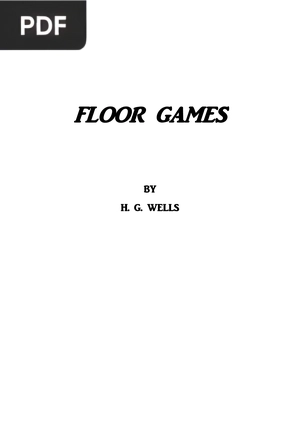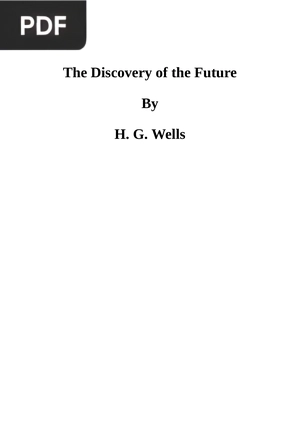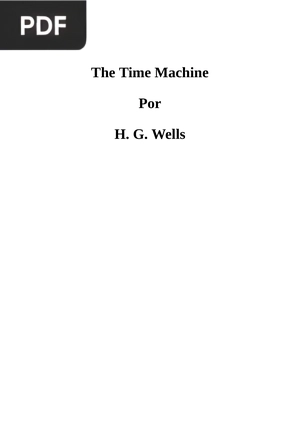First and Last Things
Author: H. G. Wells
*Wait a few seconds for the document to load, the time may vary depending on your internet connection. If you prefer, you can download the file by clicking on the link below.
Information
Description: <p><strong>First and Last Things</strong> is a philosophical work of 1908 divided into four books (Metaphysics, Of Belief, Of General Conduct and Some Personal Things), in which Wells exposes his beliefs and reflections.</p> <p>The English author affirms that the mind cannot be trusted uncritically, and that beliefs are not convictions, but positions that are adopted. He criticizes Christianity because he does not believe in the existence of a divine-human mediator, it should be noted that this was written before his religious conversion, in fact in 1917 he made an extensive revision of the book, but later in 1929 he published a new revision in which he returned much of the book to its previous form.</p> <p>He states that "What am I to do?" is the perpetual question of our existence, and recognizes that the human species remains unawakened as a whole and sunk in the delusion of the separation of the individual and of races and nations. Other themes are love, death and life.</p>
Pages: 182
Megabytes: 2.5 MB
This may interest you
Floor Games
Extension: PDF | 16 pages
<p>It is a book published in 1911 that describes a series of games designed for young children. It is said that Wells had so much fun playing with his children that he decided to write a book to guide other parents in creative play.</p> <p><strong>Floor Games</strong> games could be played indoors and included the following toys: soldiers about two inches tall; large wooden bricks and boards; electric railway rolling stock and rails. For Wells these elements were versatile, as, for example, the boards and planks can be used to create various imaginative geographies, such as cities, or also to realize engineering projects.</p> <p>Today, Floor Games is considered a guide book on learning through play, as well as non-verbal child psychotherapy. If you are a parent, it will surely inspire you to create enchanting stories with magical worlds and miniature figures.</p>
The Discovery of the Future
Extension: PDF | 19 pages
<p>This is a philosophical lecture originally delivered at the Royal Institution on January 24, 1902, which argues for the possibility of knowing the general (but not the individual) future. It was subsequently published in book form in February 1902.</p> <p>To begin with, Wells distinguishes two types of mind among people: one oriented to the past (which he describes as passive and submissive) and another that gives importance to what will happen in the future (which for him would be creative, modern and active).</p> <p>In <strong>The Discovery of the Future</strong>, the English writer analyzes the reasons for the predominance of minds that give importance to what happened in the past, which he considers to be due to the fact that what we know of the past is evidently greater than what we know of the future. Although, for him, despite the unpredictability of human behavior, the inference that the future is unknowable did not go with modern science.</p>
The Time Machine
Extension: PDF | 66 pages
<p><strong>The Time Machine</strong> is a science fiction novel published in 1895 and written in story form. The work is generally credited with popularizing the concept of time travel through the use of a vehicle or device to intentionally and selectively travel forward or backward in time. The term «time machine», coined by Wells, is now almost universally used to refer to such a vehicle or device.</p> <p>The Time Machine has been adapted into three feature films of the same name, as well as two television versions and many comic book adaptations. It has also indirectly inspired many other works of fiction in many media.</p>
The War of the Worlds
Extension: PDF | 263 pages
<p><strong>The War of the Worlds</strong> is a science fiction novel by the English author, first published in 1897 by Pearson's Magazine in the United Kingdom and by Cosmopolitan magazine in the United States.</p> <p>The novel's first appearance in hardcover was in 1898 by publisher William Heinemann of London. Written between 1895 and 1897, it is one of the first stories to detail a conflict between humanity and an alien race. The novel is the first-person narrative of an unnamed protagonist in Surrey and his younger brother in London when southern England is invaded by Martians. The novel is one of the most talked about works in the science fiction canon.</p>
This Misery of Boots
Extension: PDF | 15 pages
<p>It is a 1907 political treatise advocating socialism, being an expansion of a 1905 essay. It consists of five chapters in which Wells condemns private ownership of land and naturally produced things. He also supports expropriation by the "state" and the administration of land, business, etc.</p> <p>From the mid-1880s, Wells considered himself a socialist, which was marked by a unique personal bias. As a result, he went on to write numerous essays and four books in favor of and in promotion of this political, social and economic system.</p> <p><strong>The Misery of Boots</strong> is one of such works, where he argues that socialism requires a complete change of the entire system, and that one of the greatest problems it faced was to gain the enthusiasm and loyal cooperation of large masses of people.</p>











































